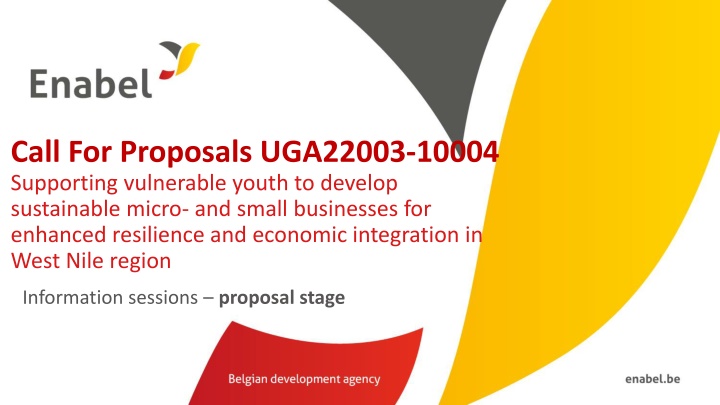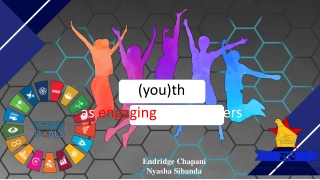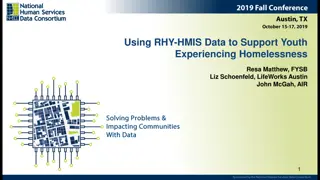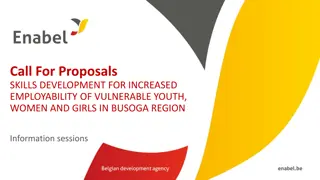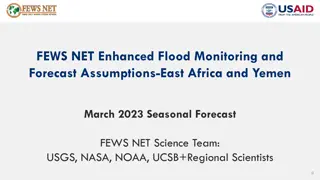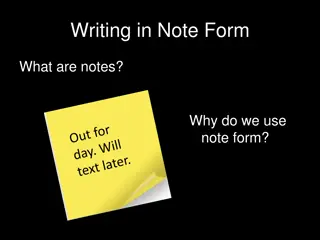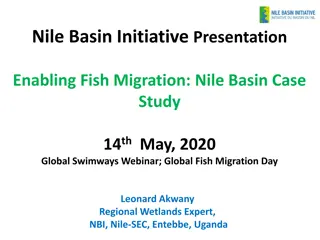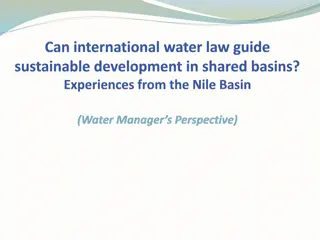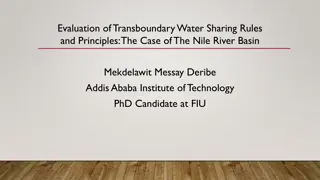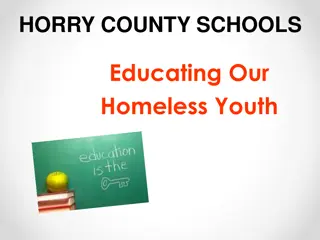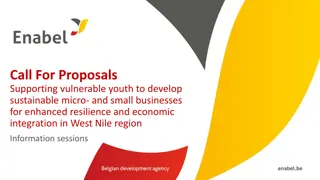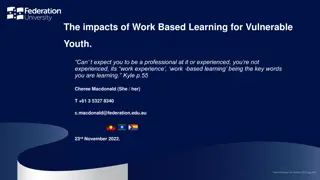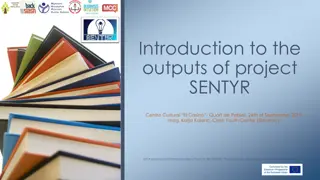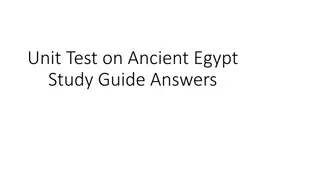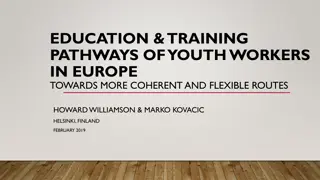Supporting Vulnerable Youth in West Nile Region
This call for proposals aims to support vulnerable youth, including young women, in developing sustainable micro- and small businesses for enhanced resilience and economic integration in the West Nile region. The goal is to improve livelihoods through access to self-employment opportunities and quality business development support.
Download Presentation

Please find below an Image/Link to download the presentation.
The content on the website is provided AS IS for your information and personal use only. It may not be sold, licensed, or shared on other websites without obtaining consent from the author.If you encounter any issues during the download, it is possible that the publisher has removed the file from their server.
You are allowed to download the files provided on this website for personal or commercial use, subject to the condition that they are used lawfully. All files are the property of their respective owners.
The content on the website is provided AS IS for your information and personal use only. It may not be sold, licensed, or shared on other websites without obtaining consent from the author.
E N D
Presentation Transcript
Call For Proposals UGA22003-10004 Supporting vulnerable youth to develop sustainable micro- and small businesses for enhanced resilience and economic integration in West Nile region Information sessions proposal stage
Presentation Presentation outline outline 1. Introduction & objectives - RECAP of the CfPs (slides 3-6 - Charles) 2. Concept Note selection process summary (slides 7-8 - Jude) 3. Proposal template a) Annex A; part B, proposal (slides 9-18 - Jan) b) M&E logical framework, Indicators (slides 19-27 - Adam) c) Discussion on budgeting (Budget template) (slides 28-36 - Hassan) 4. Application procedure/next steps (slides 37-44 - Paska)
1. Introduction & objectives - RECAP of the CfPs Call Objectives Call Objectives General objective The livelihoods of vulnerable youth, including young women, and refugees in West Nile and Kiryandongo, are improved and sustained through access to self-employment opportunities Specific objective Vulnerable youth, including young women, start and grow sustainable micro- or small businesses, through enhanced access to quality business development support
1. Introduction & objectives - RECAP of the CfPs Call objectives Call objectives ( (overall overall) ) 1000 vulnerable youth, including young women (ie. Skilled, unemployed youth as well as youth business-owners), are supported to start or grow sustainable micro- and small businesses through quality business development support; 1000 vulnerable youth (the same target group as under expected result 1), are supported to access affordable finance and capital to start or grow their micro- or small businesses; Good practices in (green/climate-smart) business development services for the economic integration of vulnerable youth are scaled-up.
1. Introduction & objectives - RECAP of the CfPs Result Result 4 4 - - Entrepreneurship Entrepreneurship promotion promotion Target groups 1) Un(der)employed, skilled youth start a sustainable business 2) Youth/youth group business owners Operate a sustainable business Vulnerable youth BUT w/min required skills & capacity NOT non-skilled youth in need of initial TVET
2. Concept note selection process summary CN (stage 1) selection process 65 concepts were received 21 applications failed at admissibility, while 44 proceeded to technical evaluation. 7 shortlisted concept notes invited for 2ndstage (absorbing 300% of total call volume; 4 for lot 1, 3 for lot 2) Deadline submission proposals = 9/12 at 5PM
2. Concept note selection process summary Evaluation - Concept note vs Proposals Focus CN RELEVANCE of proposed action Focus Proposals RELEVANCE of proposed methodology/strategic approaches EFFECTIVENESS & FEASIBILITY CAPACITY/EXPERIENCE
2. Concept note selection process summary Content - Concept note vs Proposals No substantial changes to the initial CN (e.g. changes to lot, districts, co-applicant) Requested contribution cannot vary more than 20% from initial estimate + must remain between the min and max that can be requested (150,000 500,000 EUR for lot 1 and 150,000 350,000 EUR for lot 2)
3. Proposal template a) Annex A; part B proposal a) Annex A; part B proposal Detailed description of the action & methodology 6 sections (description, strategic approach, methodology (who/what/when/how), action plan, risks & assumption, sustainability) log frame budget Administrative data and information for lead and co-applicant(s) The lead applicant s experience for similar and other actions Capacity to manage and perform actions (experience in the sectors) Resources (financial data, source of financing, number of people employed) The co-applicant(s) experience for similar and other actions History of cooperation with lead applicant Capacity to manage and implement actions (experience in the sectors) The associates (if any) - participate actively in the action, but are not eligible for grants and only qualify to receive daily allowances and travelling expenses) Mandate for each co-applicant and associates signed Declaration for lead applicant signed *any sub-grants must be indicated under methodology
RECAP of the CfPs Strategies promoted RECAP Strategies promoted RECAP Sustainable micro- and small business development initiatives, integrating: Business development support (training, technical assistance, coaching) Innovative approaches, (best-available) technologies and good practices (ie. green agriculture, agro-ecological principles, digital solutions/tools, ) Engagement of other private sector actors to mobilize sector-specific expertise and/or to support development of business relationships (B2B, sales or input agreements); Strategies to enhance beneficiaries access to affordable finance and capital; Where relevant, strategies towards enhanced access to assets, including land & inputs (without distorting the local ecosystem and market); Strategies to support adherence to quality standards of products and services; Support to formalization and/or occupational licensing where relevant (ie. When strongly linked to market access); Support to product diversification through value addition; Outreach and awareness activities; Other social inclusion strategies that help remove gender and other vulnerability-related barriers
! Attention points ! Detail/elaborate approaches/methodology of different elements of the action (e.g. access to finance strategies, business development support scheme, engagement of the private sector, social inclusion strategies, value chain coordination etc. - No skilling program!) Clarify clearly strategies to promote income diversification/resilience (esp for lot 1) and food security - of different value chains; are they integrated in mixed income activities - HOW? (generally missing in many CNs!) Highlight linkages between the selected value chains (why did you chose these specific VCs; how the action intends to complement business aspects to ensure continuous income generation-seasonality?) and at the different nodes of the value chain Clarify clearly (other) strategies related to market access/value chain coordination/linkages between segments Besides innovations, highlight and elaborate elements of added value (eg. Business models that address value chain constraints or missing services in a value chain)
! Attention points ! Lot 1: clarify clearly how agricultural and agro-ecological approaches are promoted/integrated Incorporate technical aspects demonstrating the potential to contribute to sustainable adoption of good practices and contribute to environmental conservation Clarify clearly the role of (and/or engagement with) each stakeholder in implementation: applicant, any co-applicant(s), any sub-grantee, any associate External stakeholders: community, local govt, private sector Ensure logical flow between activities & structuring between different phases (eg. inception, baseline, implementation, end-line) Ensure 100% alignment of structure between narrative, activity plan, budget & logframe
! Attention points ! Provision of start-up kits or inputs, tailored to specific business needs or business plans developed by targeted youth (if applicable) maximum 15% of the budget to provide a strategy on how the kits will effectively promote sustainable business development and not distort the local ecosystem and market
RECAP of the CfPs Sub-grants RECAP (if applicable) Sub-granting to sub-recipients of sub-grants is allowed for 2 categories; I. Micro-business sub-grants to youth-business owners for investment/capital II. Sub-grants to processors/off-takers for value chain integration of smallholder suppliers Sub- granting is optional not mandatory In application form, the following details should be clearly provided: 1. The description of the objectives and results to be achieved with these sub- grants, the fundamental principles, the key concepts, the mechanisms, the actors and their role in the management process; 2. The criteria and modalities for the allocation of grants, accessibility conditions sub-beneficiaries, conditions for the admissibility of sub-projects, eligibility conditions for activities, costs and expenses; 3. The procedures for examining and awarding applications; 4. The maximum amount that can be allocated by sub-beneficiary; 5. The terms of contractualization with the sub-beneficiary; 6. The procedures and modalities for disbursing resources; 7. The procedures and modalities for technical and financial monitoring; 8. The procedures and modalities of control.
RECAP of the CfPs Sub-grants RECAP (if applicable) I. Micro-business sub-grants conditions: The maximum amount for the sub-grants under this category is EUR 250 per supported youth/youth owned business; To be eligible for a micro business grant, supported youth must have successfully completed the business support scheme organized under the action and present a sound and viable business plan/model; Approval of micro business grants for supported youth/youth-owned businesses will be done by a selection committee which is to include representatives of Enabel, and by applying different evaluation criteria including (but not limited to) the viability of the business plan/model, vision/sound projections, financial need and relevance, technical and economic feasibility, experience and motivation of the applicant, etc. Types of activities eligible for micro business grants include purchase of equipment, raw materials and inventory, marketing and advertising activities, or start-up related costs for newly developed businesses; The following costs are ineligible for sub-granting: non-business-related costs (e.g. personal expenses or assets) and repayment of existing debts or loans. Payment modalities cannot include any payment in cash.
RECAP of the CfPs Sub-grants RECAP (if applicable) II. Sub-grants to processors/off-takers - conditions (1/2): The maximum amount for the sub-grants under this category is EUR 40,000 per processor/off-taker; Maximum 15% of the total budget can be allocated for sub-grants under this category; Activities for sub-grants under this category must include training/extension services to the targeted youth for enhanced productivity and quality management. Other eligible types of activities for sub-granting include provision of quality inputs, logistical support or set-up of collection points or services;
RECAP of the CfPs Sub-grants RECAP (if applicable) II. Sub-grants to processors/off-takers - conditions (2/2): To be eligible to apply sub-grants under this category, applicants must: Have demonstrated experience in this type of partnerships in the target region with processors/off-takers; Already identify and motivate the selection of the processor/off-taker(s) they would engage in the implementation of the action through sub-grants in their application and annex a signed Memorandum of Understanding with the identified entity(ies), demonstrating the commitment of both parties to the proposed partnership(s); To be eligible for sub-grants, processors/off-takers must: Establish decent and sustainable sales agreements with the youth producers/suppliers they are to support (i.e. long-term contracts with decent market prices) to ensure stable and inclusive market access/supply chain integration; Have existing training/extension services to producers/suppliers promoting their inclusive integration into the entity's supply chain; Source raw materials locally Commitment to co-finance the actions financially or through in-kind support. Payment modalities should include disbursements in instalments via bank transfer.
3. Proposal template a) Annex A; part B proposal
3. Proposal template b) M&E, framework, indicators b) M&E logical framework, indicators Use Annex C: logframe template and explain logic
3. Proposal template b) M&E, framework, indicators Logical flow Planned work Intended results Assumptions Assumptions& & risks risks Resources/ Resources/inputs inputs Activities Activities Outputs Outputs Outcome Outcome Impact Impact Number trained, sensitized Products developed and shared Equipment distributed Short term Knowledge/skills acquired Attitudes changed Change in behaviour Decisions made Actions undertaken Long term Social change Economic change Environmental change ... Problem analysis Stakeholder analysis Objectives Risk analysis Staff Time Money Materials Equipment Technology ... Workshops Meetings Field trips Trainings Service delivery ... Participant is object Participant is subject
3. Proposal template b) M&E, framework, indicators
3. Proposal template b) M&E, framework, indicators
3. Proposal template b) M&E, framework, indicators Example Impact/GO IMPACT - The livelihoods of vulnerable youth, including young women, in Albertine and Rwenzori subregions, are improved and sustained through access to self-employment opportunities 80% of project participants have enhanced their monthly income by at least 20% of monthly income and raised to at least UGX 214,000 net and above by the end of the action 60% of project participants report a 20% increase in the value of their productive and household assets by the end of the action 70% of project participants report a 50% reduction in the number of days their household experiences food insecurity compared to baseline, by the end of the action
3. Proposal template b) M&E, framework, indicators Example Outcome/SO OUTCOME - Vulnerable youth, including young women, start and grow sustainable micro- or small businesses, through enhanced access to quality business development support X% of project participants have launched a micro-business after completing a business support scheme, by the end of the action X% of project participants supported to grow their micro- business report increase their performance (operating turnover), by the end of the action X% of project participants have accessed savings and credit services by the end of the action # of business partnerships participants and private sector actors, by the end of the action established between project
3. Proposal template b) M&E, framework, indicators Example Output/results # of vulnerable youth supported to start or grow a micro/small business and completing a business support scheme, by the end of the action # of project participants prepared to access financing and matched with financiers, by the end of the action # of VSLA groups supported in savings and credit mobilization, accounting management, group governance and linkages to formal finance/credit (ie SACCO or MFI), by the end of the action
3. Proposal template b) M&E, framework, indicators
c) Proposal template - Budget The budget need to be coherent with the activities in the narrative & action plan NUMBERING: Activity 1 in the narrative planning need to be transferred to a budget line for activity 1 TIMING: if you plan activity 1 in quarter 1 only, then you will only foresee a budget in quarter 1 for that activity CODING: Codes correspond with the Logframe: Specific Objective, 01 Result number one,01 Activity Number one under result no One.A0101.3rd level relates to sub activities e.g A010101,A010102 Budget min 150,000 max 500,000 euro for lot 1 Budget min 150,000 max 350,000 euro for lot 2
c) Proposal template - Budget On a daily basis you will work with UGX, but the official max grant amount is in euro which you cannot exceed, so follow up of execution in euro is needed. FX rate of UGX 4000: 1 EUR (grantees can use their own exchange rate (based on a reliable source) to estimate the budget Exchange rate losses are ineligible costs and should be covered by the grantees themselves (e.g. through structure costs). Additionally, since the purpose of the grant is not to make money, any gains (exchange or interest) made on the funds received from Enabel must be re-used for the activities after Enabel approval.
c) Proposal template - Budget The budget is broken down in 3 cost components; 1. Operational costs (actual activity costs - general means cost): necessary and indispensable cost for achieving the objectives and results of the action, including the cost for achieving verifiable deliverables Ex : fees for instructors, consultancy fees, fuel for transporting, workshop costs, training materials, food for trainees, fees for trainees etc. 2. Management costs (costs to support the management team): identified costs related to management, supervision, coordination, monitoring, control, evaluation and financial audit which specifically originate in the implementation of the action or the justification of the Grant Ex : Salary for staff, Mid-term evaluation, special audit costs 3. Structure costs (7% max of eligible operational costs) costs related to the achievement of the social purpose of the beneficiary, which cannot be separated or charged to the budget of this action even though they are affected by the implementation of the action. They are a max of 7% of the eligible operational costs. Ex: supporting staff (those that cannot be justified under management costs through timesheets e.g., procurement), water & electricity & internet of the office etc.
c) Proposal template - Budget What are the rules concerning structure costs? - The percentage (max.7%) must be justified before signature of the Grant Agreement and correspond to the general structure costs of the grantee - It s a lump-sum and maximum 7% of operational costs - Once the % has been set and confirmed by the analysis of the grantee s accounts, no supporting document have to be provided by the grantee. In the reporting, it just appears as a separate line at the end (+ 7%).
c) Proposal template - Budget Ineligible costs (1/2): Expenses that are included in the ineligible list (see guidelines) Expenses that are incurred before or after the duration of this grant agreement Expenses that cannot be identified, verified and are not included in the grantee's accounts Expenses not in line with applicable legal fiscal and social provisions Expenses that are not reasonable, justified, not respecting the principle of good financial management, in particular concerning cost efficiency and effectiveness Expenses not in line with the action plan, not necessary to achieve the results No contributions in kind are considered
c) Proposal template - Budget Ineligible costs (2/2): Accounting entries not leading to payments Provisions for liabilities and charges, losses, debts or possible future debts Debts and debit interests Doubtful debts Currency exchange losses Loans to third parties Guarantees and securities; Costs already financed by another grant Invoices made out by other organisations for goods and services already subsidized Subcontracting by means of service or consultancy contracts to personnel members, Board members or General Assembly members of the organisation subsidized Any sub-letting to oneself Purchases of land or buildings; Compensation for damage falling under the civil liability of the organisation Employment termination compensation for the term of notice not performed Purchase of alcoholic beverages, tobacco and derived products thereof
c) Proposal template - Budget Indicative Costs
c) Proposal template - Budget Budget proposal may not differ more than 20% from the initial concept note budget and must remain within the minimum and maximum amounts Budget presentation in excel (Annex B of the grant agreement)
Budget modifications during implementation Modification between results leading to a variation not greater than 15% of amounts initially planned. Modification between activities of the same result leading to a variation not greater than 25% of the amounts initially planned. Changes between operational management costs (B) are not allowed without an amendment. Changes to structure costs (C) are not allowed. costs (A) and
4. Application procedure / Next steps 4. Application procedure / Next steps Use the complete Annex A Grant Application File, Part B. Do not use own templates & do not tweak the template Submission in English only Provide a detailed budget (annex B)- Amount requested in the proposal may not vary more than 20% in relation to the initial estimate Errors or major inconsistencies concerning the points mentioned in the instructions of the form may result in rejection (e.g., content required, pages, ) Enabel reserves the right to request clarification where the information provided does not enable it to carry out an objective evaluation
4. Application procedure / Next steps Submission Submission concept notes concept notes Deadline for application: 9/12/2024 at 5 PM EAT !!! Online submission form Submit : https://submit.link/32a SUBMISSIONS BY EMAIL/POST AUTOMATIC REJECTION
4. Application procedure / Next steps Application Application procedure procedure REMAINING QUESTIONS: uga_csc_grants@enabel.be Subject: reference number + LOT Questions can be submitted until 18/11 Answers will be published on https://www.enabel.be/grants/ latest by 28/11
4. Application procedure / Next steps Application Application procedure procedure ! Primary source of information Guidelines, annexes, clarifications (Q&A) and all other communication & updates: https://www.enabel.be/grants/ SELECT UGANDA OPEN CALLS - FILTER REFERENCE NUMBER 22003-10004
4. Application procedure / Next steps Submission Submission proposal proposal Online submission form Submit : https://submit.link/32a - Avoid last minute submission; System automatically closes when past deadline - Start working on a draft timely (you can always go back to your draft, it saves automatically) - Get documentation (annexes to the application file) ready on time; you cannot proceed to uploading application file before uploading the annexes)
4. Application procedure / Next steps NEXT STEPS NEXT STEPS November 8th, 2024* Invitations to submit the proposals NA November 18th, 2024 5:00 pm Deadline for clarification requests to the contracting authority November 28th, 2024* 5:00 pm Response to clarification requests are given by the contracting authority December 9th, 2024* Deadline for the submission of the proposals 5:00 pm Opening, administrative checks and evaluation of proposals December 10th January 17th, 2025* NA Request certificates and supporting documents relating to the grounds for exclusion (see 2.1.1 (2)) January 17th, 2024* 5:00 pm Onsite organizational analysis of the successful applicants after technical evaluation January 20th 31st, 2024* NA Receipt of certificates and supporting documents relating to the grounds for exclusion February 3rd, 2024* 5:00 pm Notification of the award decision and transmission of signed grant agreement February 5th, 2024* NA Signature of the Agreement by contracting beneficiary February 7th, 2024* NA
